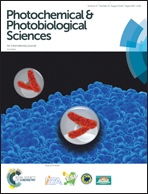Photochemical conversion of a cytidine derivative to a thymidine analog via [2+2]-cycloaddition†
Abstract
Epigenetic information is encoded in the mammalian genome in the form of cytosines methylated at the 5 position. Cytosine methylation has multiple biological effects, but our understanding of these effects has lagged because extant methods for mapping methylation sites genome-wide have severe shortcomings. For instance, the gold standard bisulfite sequencing approach suffers from the use of harsh reaction conditions resulting in DNA cleavage and incomplete conversion of unmethylated cytosine to uracil. We report here on a new photochemical method in which a DNA (cytosine-5)-methyltransferase can be used to covalently attach reactive functionalities which upon irradiation at ∼350 nm initiate photoinduced intramolecular reactions that convert modified C to T analogues. We synthesized a model compound, a cinnamyl ether-containing cytidine derivative, and demonstrated its conversion to a thymidine analogue using mild conditions and a DNA-compatible wavelength (∼350 nm), enabled by the use of a triplet sensitizer, thioxanthone. Transfer of a cinnamyl ether or comparable reactive functionality from an AdoMet analog to cytosine followed by the use of this photoconversion method would require only small amounts of DNA and allow complete methylation profiling on both long and short read sequencing platforms.
![Graphical abstract: Photochemical conversion of a cytidine derivative to a thymidine analog via [2+2]-cycloaddition](/en/Image/Get?imageInfo.ImageType=GA&imageInfo.ImageIdentifier.ManuscriptID=C8PP00161H&imageInfo.ImageIdentifier.Year=2018)


 Please wait while we load your content...
Please wait while we load your content...